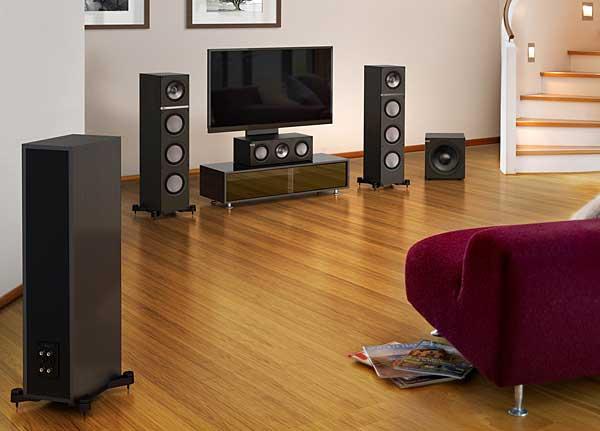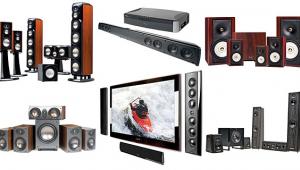I'll never touch another set of un-powered speakers after listening to an ATC home theatre setup, . I think loudspeakers are a scam in this day and age if they're not powered!
Just the Facts: Speaker Shopping & Tech Tips

Visit our How To Shop page for tips on shopping for Blu-ray Players, A/V Receivers, Flat Panel TVs and more.
HOW MANY SPEAKERS DO I NEED?
Most modern movie soundtracks and multichannel TV broadcasts carry channel signals for five primary speaker locations, referenced while facing the screen: left front, center front, right front, left surround, and right surround. A sixth channel, limited to driving low bass frequencies through a dedicated subwoofer, is known as the LFE or low-frequency effects channel. Taken together, this is a 5.1-channel system, with the “.1” referring to the frequency-limited LFE channel. Let’s take a closer look at each speaker and its respective position.
- Left and right front. The traditional stereo pair, placed equidistant from the primary listening position and from a vertical line drawn down the center of the screen.
- Center: A critically important speaker whose primary responsibility is reproducing dialogue in multichannel soundtracks. It should be placed directly above or below the center of the screen. These are often horizontal in their design to accommodate their position near the screen.
- Left and right surround. Used for creating a convincing and immersive ambient sound field, and to allow the tracking of special effects from the front to the rear of the room and vice versa. They should ideally be placed on the sidewalls above and slightly behind the main listening position. Alternately, they may be placed on waist-high stands at the sides or rear of the primary listening position, or on the back wall. Many people forgo the surround speakers because of the effort and aesthetic challenges of running wires to the rear of the room. Big mistake. These are the speakers that give a home theater system dimensionality and allow it to fully transport the viewer into the movie, TV show, or concert hall. They may be traditional speakers, or possibly dipole or bipole designs that fire sound off two or three surfaces to make them harder to localize or pinpoint while they are playing.
- Back surrounds. Most of today’s A/V receivers include amplification for an additional pair of back surround speakers to make a 7.1-channel system. These would be placed on the back wall and accompany the left- and right-surround speakers traditionally placed on either side of the primary listening position. The newest and highest quality surround sound formats found in theaters and on Blu-ray discs, Dolby TrueHD and DTS-HD Master Audio, can carry discrete signals for back surround channels, and more new movies are being mixed to take full advantage of these extra speakers. In our view, they are not a critical enhancement, though serious enthusiasts may wish to plan for them given the increasing number of 7.1-channel soundtracks.
- Front height and width surrounds. The most advanced receivers and surround processors include additional amplification and RCA outputs to also add front height speakers, which go above the main front speakers, or front width speakers, which go outside the main front speakers. These channel signals are derived artificially and are not inherent in movie or show soundtracks. They remain a questionable enhancement given today’s recorded soundtracks and are not essential for a satisfying home theater experience.
To create a coherent and seamless sound field, it’s critically important that all the speakers, excepting the subwoofer, be designed to work together. Buy all five of the main speakers from the same manufacturer, and make sure they are part of the same line that has been “voiced” to work together. This usually means similar drivers and crossover designs have been used. Since the subwoofer reproduces none of the high and middle frequencies that provide cues that would betray a mismatch, almost any subwoofer can be mated with a system, provided that the primary speakers go low enough and the subwoofer high enough in frequency to create a seamless blend. Packaged “subwoofer/satellite” systems are readily available to take the guesswork out of matching speakers.
THX CERTIFICATION
A few manufacturers pay THX, a company that independently measures and verifies performance, to test and certify their speakers. When mated with an appropriate THX-certified amplifier or A/V receiver, THX-certified speakers will attain the industry “reference-level” volume (a very loud 105 decibels) in rooms up to 3,000 cubic feet (THX Ultra2 Plus), up to 2,000 cubic feet (THX Select2 Plus), and 1,000 square feet (THX Compact Speaker, which utilizes any Select2 Plus A/V receiver).
KEY SPECIFICATIONS
- Frequency Response. Describes the range of audible frequencies the speaker is designed to reproduce with the full range of frequencies often cited as 20 hertz (Hz) to 20,000 Hz. Human hearing typically does not extend up to 20kHz and bass frequencies below 30 Hz or so tend to be felt more than heard. Manufacturer stated specifications (as opposed to independent measurements by a magazine or website) may be dubious, but will give a general idea of where a speaker drops off at the low end.
- Voltage Sensitivity. Typically given in decibels, as in 85 dB. Describes the efficiency of a speaker, or how loud it will play given a certain industry-standard test signal. Effective for comparing one speaker with another and mating it with an amplifier. 80 dB to anywhere in the mid-80’s dB range would be considered typical for most speakers, anything near or over 90 dB would be considered highly efficient, meaning a speaker with a 90 dB sensitivity rating will play louder than models that have lower ratings, given the same power input.
- Log in or register to post comments


Thank you for sharing these tips!

Thanks for sharing your perspective. This helps a ton!
















































